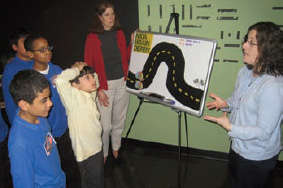Some 750 students from Washington, D.C., and surrounding areas learned about brain anatomy and function, as well as dysfunction, from a series of hands-on activities during Brain Awareness Week, March 16-20. NIDA sponsored two of the activities held at the National Museum of Health and Medicine in Washington, D.C.
 Brain Awareness Week: NIDA scientist Dr. Allison Hoffman (right) explains the rules of the Brain Derby to a group of fifth-grade students as Dr. Cathrine Sasek of the Office of Science Policy and Communications looks on.
Brain Awareness Week: NIDA scientist Dr. Allison Hoffman (right) explains the rules of the Brain Derby to a group of fifth-grade students as Dr. Cathrine Sasek of the Office of Science Policy and Communications looks on.Groups of students rotated through nine activities there, each lasting about 20 minutes. For instance, they watched a "tumor" being surgically removed from a Jell-O brain, built a model brain, and learned the functions of each lobe when healthy and when injured or diseased.
In one of the NIDA-sponsored activities called "Are You Smarter Than a Neuroscientist?", two teams of students competed to answer computer-generated questions about the brain and the effects of drugs on the brain.
To start, a NIDA official clicked a mouse and a multiple-choice question appeared on the screen. Each team took turns answering. Some of the questions seemed easy—e.g., Addiction occurs when a person:
- can stop doing something (like take drugs) whenever they want;
- cannot stop doing something even though they may want to;
- uses illegal drugs;
- takes a drug once.
Others were clearly challenging—e.g., Marijuana can change learning and memory by acting in which part of the brain?
- Hippocampus
- Brain stem
- Visual cortex
- All of the above
If the team chose (b) in the first example or (a) in the second, "Congratulations, you got it right" would appear on the screen, and that team would earn a point.
In a second game, "Welcome to Roger's Party," students took turns putting on a pair of goggles that simulated the disorienting effects of alcohol or drug intoxication. They then tried to navigate an obstacle course.
Dr. Roger Sorensen of NIDA's Division of Basic Neuroscience and Behavioral Research began each session by asking the students what they knew about the effects of alcohol and drugs. Their responses prompted a discussion about the dangers of substance abuse and gave him a chance to affirm or correct perceptions.
The students' experiences with the goggles reinforced the discussion. Dr. Sorensen explains: "After a student gets a turn wearing the goggles and walking around the maze, I ask him or her how it feels. The typical response is, 'I felt dizzy. I didn't like it.'"
Brain Awareness Week is an annual event, sponsored by the Dana Alliance for Brain Initiatives, to educate the public about brain science. The program is designed especially for middle school students, but this year's attendees ranged from the 5th through the 12th grade. About 20 public and private schools and six home-school networks in Maryland, Virginia, and the District of Columbia participated in the program.
